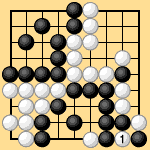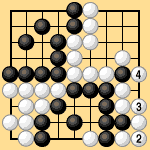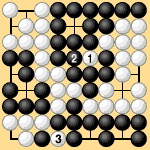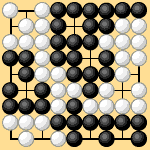 |
2.3.3 Questions of Reinforcement (2)
|
The 1949 Nihon Kiin Laws state that one reinforcing moves is required
in the top left of Dia. 2-8, and no reinforcing move is required in the
bottom left, but this too is explained by means of a precedent. The
phrase "direct ko," if not actually ambiguous, can be easily
misinterpreted, and the ruling is unnatural.
|
 |
| Dia. 2-8 |
|
White has more ko threats in Dia. 2-9-1. Does he have to add
reinforcements at 2, 3, and 4 in Dia. 2-9-2? If a pass is not recognized
as a ko threat, these reinforcements are unnecessary and White wins by
one point, as you may verify.
|
 |
 |
| Dia. 2-9-1 |
Dia. 2-9-2 |
|
Many people may feel dissatisfied about this. It has been suggested
that the final pass should be admitted as a ko threat. Another way is
to allow recreation of a former position (by capturing a ko) after two
consecutive passes. This leads to the proposal that the game should end
with three consecutive passes. The purpose is to avoid anomalies just
prior to the end of the game (to use Shimada's expression), but if you
leave life and death undefined, the occurrences in question are not
necessarily anomalous. Dia. 2-10-1 shows another one. Black has no way
to capture the white group in the bottom left. After White 1, Black 2,
and White 3, Black can only pass. White also passes. If you do not admit
exceptions to the rule that a pass is not a ko threat, the game ends as
in Dia. 2-10-2 and the bottom left white group stays on the board (is
alive).
|
 |
 |
| Dia. 2-10-1 |
Dia. 2-10-2 |
|
If exceptions are admitted after two consecutive passes, further unusual
positions can occur. We will return to these when we come to the subject
of ko and its generalization.*
- *
- Under the 1989 Japanese Rules of Go, Black needs to reinforce at
both 1 and 2 in Dia. 2-6. After Dia. 2-7-3 White must make two further
moves to capture all the black stones in the bottom right corner. White
2, 3, and 4 in Dia. 2-9-2 are also necessary. The white group in the
bottom left of Dia. 2-10-2 is dead.
|
| |
 |






